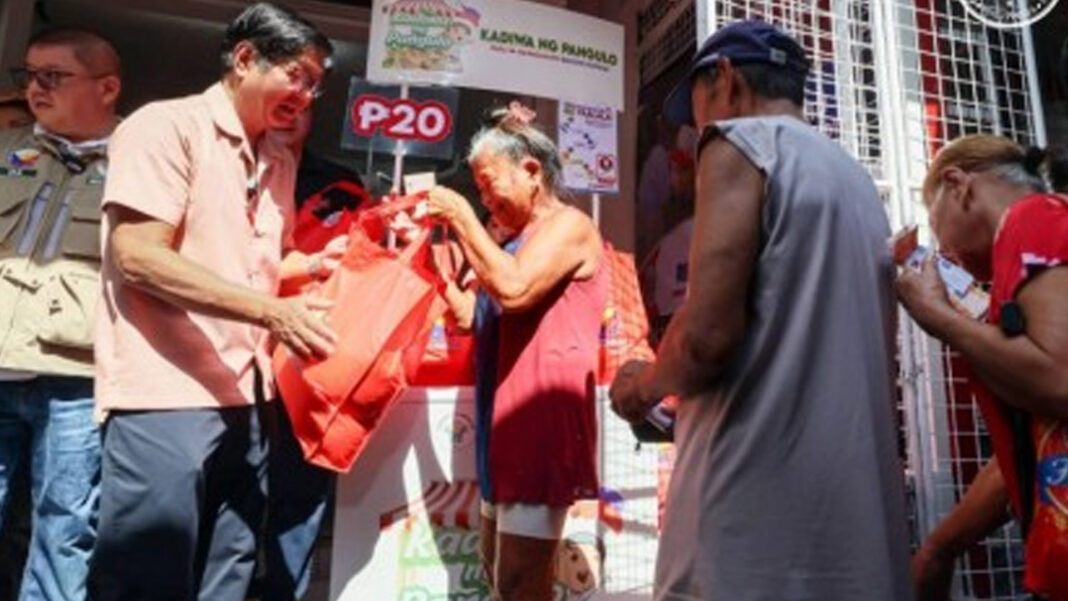Since its launch in May, President Ferdinand R. Marcos Jr.’s initiative to provide PHP20 per kg. rice to vulnerable sectors has benefitted close to a million Filipinos, the Department of Agriculture (DA) reported on Tuesday.
The subsidized rice provided by the DA under the “Benteng Bigas Meron (BBM) Na!” program is available to senior citizens, persons with disabilities, solo parents, beneficiaries of the Pantawid Pamilyang Pilipino Program (4Ps) and the Walang Gutom Program, and minimum wage earners.
As of July 14, a total of 2,105 metric tons (MT) of subsidized rice were sold to 217,614 households.
“At 217,000 households already benefitting at four persons per household, we’re almost hitting 1 million total beneficiaries for the Benteng Bigas Meron Na program,” DA spokesperson Assistant Secretary Arnel De Mesa told the Philippine News Agency in an interview.
He said the realization of the President’s promise to provide affordable yet quality rice at PHP20 per kg. makes the government’s food security efforts felt on the ground.
Data from the DA showed that the PHP20 per kg. rice is available in 162 out of the 699 operational Kadiwa ng Pangulo (KNP) centers and stores nationwide.
These include KNP Centers, kiosks, pop-up stores, and partner agencies and local government units (LGUs) in Metro Manila; the Cordillera region (Benguet); Ilocos region (La Union, Pangasinan); Cagayan Valley (Cagayan); Central Luzon (Aurora, Bulacan, Nueva Ecija, and Pampanga); Calabarzon (Cavite, Laguna, Batangas, Rizal, and Quezon); and Mimaropa (Oriental and Occidental Mindoro, and Palawan).
The BBM Na is also accessible in select areas in the Bicol region (Albay); Western Visayas (Bacolod, Iloilo, and Guimaras); Central Visayas (Cebu, Negros Oriental, Siquijor); Eastern Visayas (Leyte); Zamboanga Peninsula (Zamboanga del Sur); Northern Mindanao (Cagayan de Oro); Davao region (Davao del Sur); Soccsksargen (South Cotabato); and Caraga (Agusan del Norte).
De Mesa said more LGUs are finalizing details to implement the BBM Na program.
Under the program, the partner-LGUs and the Department of Agriculture will have a counterpart subsidy share to reduce the cost of rice to PHP20 per kg.
“Ang target nga natin diyan ang 1,500 sites bago matapos ang 2028. At ayan ay patuloy na dumadami (Our target is 1,500 sites before the end of 2028. And these are continuously increasing),” de Mesa said.
The DA was initially granted PHP4.5 billion from the contingency fund of the Office of the President to roll out the BBM Na program.
De Mesa said the target is to make BBM Na available to 15 million beneficiaries.
The supply of rice for the program comes from the National Food Authority (NFA), which bought palay from local farmers at PHP17 per kg. for fresh and wet palay and up to PHP24 per kg. for clean and dry palay.
Partner agencies include the Philippine Postal Corp. (PHLPost), the Department of Labor and Employment (DOLE), the Department of Migrant Workers (DMW), and the Department of Social Welfare and Development (DSWD).
Malacañang earlier said the Marcos administration is optimistic that all Filipinos, not just the vulnerable sectors, would be able to buy PHP20 per kg. of rice by 2026.
Taming rice inflation
Besides the BBM Na, the Marcos administration has also implemented various measures to tame the retail price of rice to ensure the welfare of the general public.
Among these are Executive Order (EO) 62, which reduced the tariffs on imported rice to 15 percent from 35 percent; the gradual reduction of the maximum suggested retail price (MSRP) for 5 percent broken imported rice; the declaration of food security emergency for rice; and the availability of the Rice for All (RFA) program.
“Ito iyong dahilan o major reason bakit malaki iyong ibinaba ng food inflation dahil iyong lahat ng klase ng bigas sa merkado, bumaba (This is the cause or major reason of the significant drop in food inflation, because of the decline in retail prices of rice varieties),” de Mesa said.
As of July 14, the price per kg. of imported premium rice in Metro Manila ranges from PHP45 to PHP46; imported well-milled rice, PHP38 to PHP45; and imported regular-milled rice, PHP33 to PHP45, according to the DA Bantay Presyo (price watch).
The price per kg. of local premium rice, meanwhile, ranges from PHP46 to PHP57; local well-milled, PHP37 to PHP50; and local regular-milled rice, PHP35 to PHP42, with a prevailing price of PHP40 per kg.
De Mesa also underscored the positive reception and compliance of importers and retailers, as well as local sellers, with government measures in helping tame rice prices.
“The downtrend of global rice prices was easily translated in local markets,” he said.
On Jan. 20, the MSRP for 5 percent broken rice was initially set at PHP58 per kg. It now stands at PHP45/kg. and will be reduced to PHP43 per kg. on July 16.
The RFAs, meanwhile, include RFA 5, or the 5 percent broken, which sells at PHP43 per kg.; RFA 25, or the 25 percent broken, at PHP35 per kg.; RFA 100, also known as Sulit rice or 100 percent broken, at PHP33 per kg.
Before the government interventions, the price per kg. of retail rice in Metro Manila ranged from PHP60 to PHP70 for special premium-grade rice, in early July 2024, according to the DA-Bantay Presyo.
Other rice varieties hit a range of upper PHP40s to middle PHP50s for imported regular and well-milled rice.
Based on data from the Philippine Statistics Authority, rice inflation persisted from July 2023 to November 2024, beyond the government’s 4 percent rice inflation target.
It surged to as high as 8 percent in August 2023; 17 percent in September 2023; and more than 20 percent across several months in 2024. (PNA)


